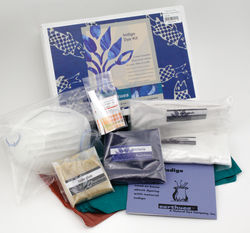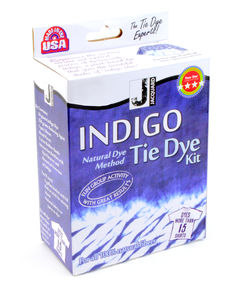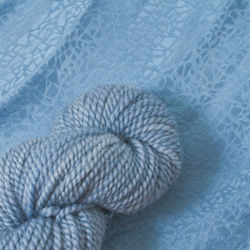Indigo dyed bed linens from the book Natural Color, by Sasha Duerr.
It’s easy to fall in love with the distinctive blue hues of indigo. It’s also surprisingly easy and incredibly fun to turn your favorite yarns and fibers blue with this ancient dye. At our Open House this year we’re celebrating this wonderful blue dye with a community indigo dye vat. It looks like magic, but it’s surprisingly easy to explore indigo on your own too!

Detail of an indigo dyed cotton wall hanging, by Barbara Goldberg, from the book Shibori, The Inventive Art of Japanese Shaped Resist Dyeing, by Yoshiko Iwamoto Wada, Mary Kellogg Rice & Jane Barton.
Indigo is an anciant natural dye, derived from the leaves of the indigo plant. Known for the beautiful shades of blue it produces, Indigo can be used on both protein (animal-based) and cellulose (plant-based) fibers. This unique dye offers a world of possibilities, and evidence of its rich history can be seen all over the world. Safe and non-toxic, this is a great dye for clothing, or try it for table linens or curtains, you name it and we promise it’ll look good in blue!

Detail of an indigo dyed garment by Virginia Davis, from the book Shibori, The Inventive Art of Japanese Shaped Resist Dyeing.
If you’d like to try your hand at indigo dyeing here are some items we recommend:
Earthues Dye (Indigo - So Asian, Sky blue-midnight) requires a bit more finesse and creates gorgeous color, or for something a little easier we’re delighted to discover the new Pre-Reduced Indigo, which doesn’t require heat or quite as much prep to prepare the vat. These will require the following materials:
For some great books that feature natural dye techniques and fascinating indigo and natural dye lore:


Caring for your indigo dyed goods, and a note about crocking…
The way Indigo works is by building up dye materials and bonding onto the surface of the fibers. That means that sometimes a little friction may cause a little bit of blue to rub off. Ever end up with blue legs after wearing a new pair of jeans? This is called crocking, and it is completely normal. Indigo is quite colorfast as soon as it hits the air out of the vat and oxidizes, even when it crocks. If your fingers are a little stained after knitting with some Indigo dyed yarn, don’t worry – it’ll wash right off.
While it isn’t always necessary to give your newly dyed fiber a thorough wash, this step will help keep that lovely blue from transferring onto lighter colors. How to wash your fiber depends on what you dyed:
PROTEIN FIBERS (Wool, aplaca, silk, etc.)
Before washing, try letting it soak for an extra 30 minutes or so in cool water with a generous glug of white vinegar to neutralize the remaining dye solution and help protect the fibers. Hand wash your fiber in cool to lukewarm water using a mild detergent. Do not agitate, just swirl it around gently for a minute or two. Rinse in lukewarm water and hang or lay flat to dry. Tip: Be super gentle, especially when dying unspun roving! The pH of the Indigo vat has made this fiber very delicate and more prone to felting!
PLANT-BASED FIBERS (Cotton, linen, hemp, etc.)
Yarn: Hand wash gently in lukewarm to warm water using a mild detergent, no need for the vinegar rinse. Rinse thoroughly and hang to dry.
Fabric/clothing: Hand or machine wash by itself. Dry as desired; hang dry is recommended.





